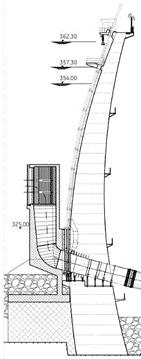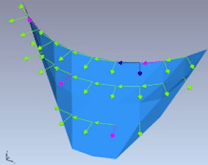Dams are considered one of the most significant civil engineering structures built across rivers to create reservoirs for impounding water used for various purposes. With their complex geometric shape, curved in plan, and convex towards the upstream side, arch dams present a great challenge for design and construction. Their structural stability and safety are highly important because of the large potential threat to life and property due to the retention of large quantities of water.
In this blog post, we focused on the structural identification of St. Petka Dam in North Macedonia with the innovative products offered by Digitex Systems.
St. Petka Dam
The St. Petka Arch Dam is located in the Treska Canyon River, between the Kozjak Earth Dam and Matka Arch Dam, approximately 30 km from the city of Skopje, the capital of North Macedonia. The purpose of the St. The Petka dam regulates runoff water from the Kozjak dam and hydropower production. It accumulates a maximum of 9.1×106 m3 of water in the reservoir, Fig. 1. The dam has double curvature in the horizontal and vertical directions, and its geometry is determined from the geometry of the arches and central cantilever [1]. Vertical section cantilevers have variable thicknesses. The dam height was 64 m, with a thickness on the top of 2.0 m, gradually increasing to 10 m at the bottom. The structure was built over six years (2006-2012) with several interruptions using 27362 m3 of concrete for the dam body.
Structural identification of St Petka Dam with empty reservoir
Ambient vibration tests at St. Petka Dam were conducted on March 12, 2013, during the initial discharging of the water accumulation. Six series of AV tests were conducted, and each series contained results from acceleration sensors located at different locations on the crest and along the dam height. Four roving accelerometers and a fixed reference sensor (R) located on the crest were used, as shown in Fig. 2. All the sensors were triaxial and positioned next to each construction joint of the body. Digitex PDAQ system acquisition and D110-T triaxial accelerometers were used, as shown in Fig. 3.


Fig. 1. (a) Aerial view of St Petka dam
Fig. 1 (b) Central cross-section of the dam

Fig. 2. Accelerometer location, downstream side view


Fig. 3. Accelerometer location on the crest and PDAQ locations during one series of testing
Operational Modal Analysis (OMA) was applied to assess the modal properties of the dam under ambient vibrations or normal operating conditions. The measured ambient vibration response of the dam was analyzed using the Frequency Domain Decomposition (FDD) method. Two distinctive mode shapes were identified at 6.84 Hz and 11.13 Hz that correspond well with the design mode shapes.



a) Sensor location and test directions
b) Mode shape at f= 6.84 Hz
c) Mode shape at f= 11.13 Hz
Fig. 2. Accelerometer location, downstream side view
Digitex Systems offers state-of-the-art SHM solutions that utilize cutting-edge technology to monitor the structural integrity of critical infrastructures. These products play a crucial role in ensuring the safety and longevity of dams and buildings, bridges, reservoirs, mining facilities, and more.
By harnessing real-time data and advanced sensor technology, Digitex Systems empowers engineers and professionals to assess structural health and promptly identify potential issues. This proactive approach helps prevent catastrophic failures and ensures the safety of lives and property.
SOURCES:
1. Simonche V. St. Petka arch dam, A guard of Skopje safety. Presing, Journal of the Chamber of Certified Architects and Certified Engineers of Republic of Macedonia, Vol. 10, August 2012, pp. 30-36




